| Listing 1 - 10 of 10 |
Sort by
|
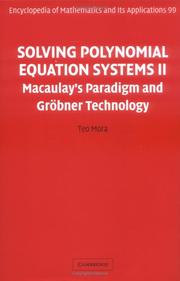
ISBN: 9781107340954 9780521811569 1107340950 9781107266902 1107266904 9781299707610 1299707610 9781107269989 1107269989 9780521811545 0521811546 0521811562 9780521811552 0521811554 1139883003 1107266556 110726443X 1107263344 1107267978 9781139015998 Year: 2005 Volume: v. 99 Publisher: Cambridge Cambridge University Press
Abstract | Keywords | Export | Availability | Bookmark
 Loading...
Loading...Choose an application
- Reference Manager
- EndNote
- RefWorks (Direct export to RefWorks)
The second volume of this comprehensive treatise focusses on Buchberger theory and its application to the algorithmic view of commutative algebra. In distinction to other works, the presentation here is based on the intrinsic linear algebra structure of Groebner bases, and thus elementary considerations lead easily to the state-of-the-art in issues of implementation. The same language describes the applications of Groebner technology to the central problems of commutative algebra. The book can be also used as a reference on elementary ideal theory and a source for the state-of-the-art in its algorithmization. Aiming to provide a complete survey on Groebner bases and their applications, the author also includes advanced aspects of Buchberger theory, such as the complexity of the algorithm, Galligo's theorem, the optimality of degrevlex, the Gianni-Kalkbrener theorem, the FGLM algorithm, and so on. Thus it will be essential for all workers in commutative algebra, computational algebra and algebraic geometry.
Equations --- Polynomials. --- Iterative methods (Mathematics) --- Iteration (Mathematics) --- Numerical analysis --- Algebra --- Numerical solutions. --- Graphic methods --- Gröbner bases. --- Gröbner basis theory --- Commutative algebra
Book
ISBN: 085729105X 0857291068 Year: 2011 Publisher: London : Springer London : Imprint: Springer,
Abstract | Keywords | Export | Availability | Bookmark
 Loading...
Loading...Choose an application
- Reference Manager
- EndNote
- RefWorks (Direct export to RefWorks)
This book demonstrates current trends in research on combinatorial and computational commutative algebra with a primary emphasis on topics related to monomial ideals. Providing a useful and quick introduction to areas of research spanning these fields, Monomial Ideals is split into three parts. Part I offers a quick introduction to the modern theory of Gröbner bases as well as the detailed study of generic initial ideals. Part II supplies Hilbert functions and resolutions and some of the combinatorics related to monomial ideals including the Kruskal—Katona theorem and algebraic aspects of Alexander duality. Part III discusses combinatorial applications of monomial ideals, providing a valuable overview of some of the central trends in algebraic combinatorics. Main subjects include edge ideals of finite graphs, powers of ideals, algebraic shifting theory and an introduction to discrete polymatroids. Theory is complemented by a number of examples and exercises throughout, bringing the reader to a deeper understanding of concepts explored within the text. Self-contained and concise, this book will appeal to a wide range of readers, including PhD students on advanced courses, experienced researchers, and combinatorialists and non-specialists with a basic knowledge of commutative algebra. Since their first meeting in 1985, Juergen Herzog (Universität Duisburg-Essen, Germany) and Takayuki Hibi (Osaka University, Japan), have worked together on a number of research projects, of which recent results are presented in this monograph.
Algebra. --- Mathematics. --- Commutative algebra --- Combinatorial analysis --- Grèobner bases --- Characteristic functions --- Mathematics --- Physical Sciences & Mathematics --- Algebra --- Commutative algebra. --- Commutative rings. --- Commutative Rings and Algebras. --- Mathematical analysis --- Characteristic functions. --- Combinatorial analysis. --- Gröbner bases. --- Rings (Algebra)
Book
ISBN: 4431545735 4431545743 Year: 2013 Publisher: Tokyo : Springer Japan : Imprint: Springer,
Abstract | Keywords | Export | Availability | Bookmark
 Loading...
Loading...Choose an application
- Reference Manager
- EndNote
- RefWorks (Direct export to RefWorks)
The idea of the Gröbner basis first appeared in a 1927 paper by F. S. Macaulay, who succeeded in creating a combinatorial characterization of the Hilbert functions of homogeneous ideals of the polynomial ring. Later, the modern definition of the Gröbner basis was independently introduced by Heisuke Hironaka in 1964 and Bruno Buchberger in 1965. However, after the discovery of the notion of the Gröbner basis by Hironaka and Buchberger, it was not actively pursued for 20 years. A breakthrough was made in the mid-1980s by David Bayer and Michael Stillman, who created the Macaulay computer algebra system with the help of the Gröbner basis. Since then, rapid development on the Gröbner basis has been achieved by many researchers, including Bernd Sturmfels. This book serves as a standard bible of the Gröbner basis, for which the harmony of theory, application, and computation are indispensable. It provides all the fundamentals for graduate students to learn the ABC’s of the Gröbner basis, requiring no special knowledge to understand those basic points. Starting from the introductory performance of the Gröbner basis (Chapter 1), a trip around mathematical software follows (Chapter 2). Then comes a deep discussion of how to compute the Gröbner basis (Chapter 3). These three chapters may be regarded as the first act of a mathematical play. The second act opens with topics on algebraic statistics (Chapter 4), a fascinating research area where the Gröbner basis of a toric ideal is a fundamental tool of the Markov chain Monte Carlo method. Moreover, the Gröbner basis of a toric ideal has had a great influence on the study of convex polytopes (Chapter 5). In addition, the Gröbner basis of the ring of differential operators gives effective algorithms on holonomic functions (Chapter 6). The third act (Chapter 7) is a collection of concrete examples and problems for Chapters 4, 5 and 6 emphasizing computation by using various software systems.
Gröbner bases. --- Mathematics --- Physical Sciences & Mathematics --- Algebra --- Gröbner basis theory --- Statistics. --- Statistical Theory and Methods. --- Statistics and Computing/Statistics Programs. --- Statistics for Engineering, Physics, Computer Science, Chemistry and Earth Sciences. --- Commutative algebra --- Mathematical statistics. --- Statistical analysis --- Statistical data --- Statistical methods --- Statistical science --- Econometrics --- Statistical inference --- Statistics, Mathematical --- Statistics --- Probabilities --- Sampling (Statistics) --- Statistics .
Book
ISBN: 3030039048 303003903X Year: 2018 Publisher: Cham : Springer International Publishing : Imprint: Springer,
Abstract | Keywords | Export | Availability | Bookmark
 Loading...
Loading...Choose an application
- Reference Manager
- EndNote
- RefWorks (Direct export to RefWorks)
This book is divided into two parts, one theoretical and one focusing on applications, and offers a complete description of the Canonical Gröbner Cover, the most accurate algebraic method for discussing parametric polynomial systems. It also includes applications to the Automatic Deduction of Geometric Theorems, Loci Computation and Envelopes. The theoretical part is a self-contained exposition on the theory of Parametric Gröbner Systems and Bases. It begins with Weispfenning’s introduction of Comprehensive Gröbner Systems (CGS) in 1992, and provides a complete description of the Gröbner Cover (GC), which includes a canonical discussion of a set of parametric polynomial equations developed by Michael Wibmer and the author. In turn, the application part selects three problems for which the Gröbner Cover offers valuable new perspectives. The automatic deduction of geometric theorems (ADGT) becomes fully automatic and straightforward using GC, representing a major improvement on all previous methods. In terms of loci and envelope computation, GC makes it possible to introduce a taxonomy of the components and automatically compute it. The book also generalizes the definition of the envelope of a family of hypersurfaces, and provides algorithms for its computation, as well as for discussing how to determine the real envelope. All the algorithms described here have also been included in the software library “grobcov.lib” implemented in Singular by the author, and serve as a User Manual for it.
Gröbner bases. --- Gröbner basis theory --- Commutative algebra --- Algebra. --- Field theory (Physics). --- Algebra --- Commutative Rings and Algebras. --- Field Theory and Polynomials. --- Symbolic and Algebraic Manipulation. --- Data processing. --- Classical field theory --- Continuum physics --- Physics --- Continuum mechanics --- Mathematics --- Mathematical analysis --- Commutative algebra. --- Commutative rings. --- Computer science—Mathematics. --- Rings (Algebra)
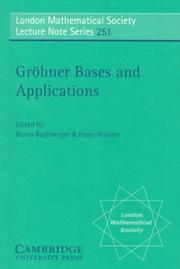
ISBN: 113988543X 1107365147 1107362695 1107367603 110737216X 1107369355 0511565844 9781107362697 9780511565847 0521632986 9780521632980 Year: 1998 Publisher: Cambridge, U.K. New York Cambridge University Press
Abstract | Keywords | Export | Availability | Bookmark
 Loading...
Loading...Choose an application
- Reference Manager
- EndNote
- RefWorks (Direct export to RefWorks)
This book provides an easy-to-read account of the theory of Gröbner bases and applications. It is in 2 parts, the first consists of tutorial lectures, and the second, 17 original research papers on Gröbner bases.
Gröbner bases. --- Coding theory --- Gröbner basis theory --- Commutative algebra --- Geometry, Algebraic --- Géométrie algébrique. --- Algorithms --- Algorithmes. --- Anneaux de polynômes. --- Polynomial rings. --- Algèbres commutatives. --- Polynômes --- Polynomials --- 512.56 --- 512.56 Lattices, including Boolean rings and algebras --- Lattices, including Boolean rings and algebras --- Grobner bases. --- Géométrie algébrique --- Algorithmes --- Anneaux de polynômes. --- Algèbres commutatives. --- Polynômes
Book
ISBN: 3540938052 9786612364532 1282364537 3540938060 Year: 2009 Publisher: Berlin : [Linz, Austria] : Springer ; RISC,
Abstract | Keywords | Export | Availability | Bookmark
 Loading...
Loading...Choose an application
- Reference Manager
- EndNote
- RefWorks (Direct export to RefWorks)
Coding theory and cryptography allow secure and reliable data transmission, which is at the heart of modern communication. Nowadays, it is hard to find an electronic device without some code inside. Gröbner bases have emerged as the main tool in computational algebra, permitting numerous applications, both in theoretical contexts and in practical situations. This book is the first book ever giving a comprehensive overview on the application of commutative algebra to coding theory and cryptography. For example, all important properties of algebraic/geometric coding systems (including encoding, construction, decoding, list decoding) are individually analysed, reporting all significant approaches appeared in the literature. Also, stream ciphers, PK cryptography, symmetric cryptography and Polly Cracker systems deserve each a separate chapter, where all the relevant literature is reported and compared. While many short notes hint at new exciting directions, the reader will find that all chapters fit nicely within a unified notation.
Coding theory. --- Cryptography. --- Gro ̈bner bases. --- Grèobner bases --- Coding theory --- Cryptography --- Mathematics --- Physical Sciences & Mathematics --- Algebra --- Gröbner bases. --- Gröbner basis theory --- Cryptanalysis --- Cryptology --- Secret writing --- Steganography --- Mathematics. --- Data encryption (Computer science). --- Computers. --- Computer science --- Algebra. --- Discrete mathematics. --- Combinatorics. --- Discrete Mathematics. --- Data Encryption. --- Mathematics of Computing. --- Theory of Computation. --- Commutative algebra --- Signs and symbols --- Symbolism --- Writing --- Ciphers --- Data encryption (Computer science) --- Data compression (Telecommunication) --- Digital electronics --- Information theory --- Machine theory --- Signal theory (Telecommunication) --- Computer programming --- Computer science. --- Information theory. --- Cryptology. --- Communication theory --- Communication --- Cybernetics --- Informatics --- Science --- Data encoding (Computer science) --- Encryption of data (Computer science) --- Computer security --- Combinatorics --- Mathematical analysis --- Computer science—Mathematics. --- Discrete mathematical structures --- Mathematical structures, Discrete --- Structures, Discrete mathematical --- Numerical analysis --- Automatic computers --- Automatic data processors --- Computer hardware --- Computing machines (Computers) --- Electronic brains --- Electronic calculating-machines --- Electronic computers --- Hardware, Computer --- Computer systems --- Calculators --- Cyberspace --- Grobner bases.
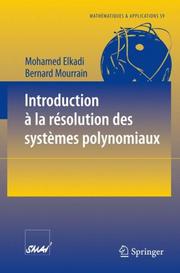
ISSN: 1154483X ISBN: 1281351598 9786611351595 3540716475 3540716467 Year: 2007 Volume: 59 Publisher: Berlin ; New York : Springer,
Abstract | Keywords | Export | Availability | Bookmark
 Loading...
Loading...Choose an application
- Reference Manager
- EndNote
- RefWorks (Direct export to RefWorks)
Les équations polynomiales apparaissent dans de nombreux domaines, pour modéliser des contraintes géométriques, des relations entre des grandeurs physiques, ou encore des propriétés satisfaites par certaines inconnues. Cet ouvrage est une introduction aux méthodes algébriques permettant de résoudre ce type d'équations. Nous montrons comment la géométrie des variétés algébriques définies par ces équations, leur dimension, leur degré, ou leurs composantes peuvent se déduire des propriétés des algèbres quotients correspondantes. Nous abordons pour cela des méthodes de la géométrie algébrique effective, telles que les bases de Grobner, la résolution par valeurs et vecteurs propres, les résultants, les bezoutiens, la dualité, les algèbres de Gorenstein et les résidus algébriques. Ces méthodes sont accompagnées d'algorithmes, d'exemples et d'exercices, illustrant leurs applications.
Gröbner bases. --- Polynomials. --- Computational complexity. --- Commutative algebra. --- Algebra --- Complexity, Computational --- Electronic data processing --- Machine theory --- Gröbner basis theory --- Commutative algebra --- Algebra. --- Computer science --- Geometry, algebraic. --- Numerical analysis. --- Commutative Rings and Algebras. --- Computational Mathematics and Numerical Analysis. --- Algebraic Geometry. --- Numerical Analysis. --- General Algebraic Systems. --- Mathematics. --- Mathematical analysis --- Algebraic geometry --- Geometry --- Computer mathematics --- Discrete mathematics --- Mathematics --- Commutative rings. --- Computer mathematics. --- Algebraic geometry. --- Rings (Algebra) --- Grobner bases.
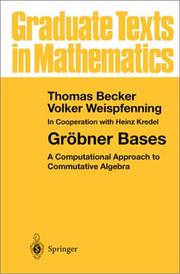
ISBN: 0387979719 3540979719 9780387979717 Year: 1993 Volume: 141 Publisher: New York, NY : Springer,
Abstract | Keywords | Export | Availability | Bookmark
 Loading...
Loading...Choose an application
- Reference Manager
- EndNote
- RefWorks (Direct export to RefWorks)
Gröbner bases --- ALGEBRA --- data processing --- Grobner bases. --- Grobner bases --- Gröbner basis theory --- Bases de Gröbner --- Gröbner bases --- Bases de Gröbner --- Algebra --- 512.55 --- 512.55 Rings and modules --- Rings and modules --- Commutative algebra --- Data processing --- Ordered algebraic structures --- Data processing. --- Algèbre --- Informatique --- Geometry, Algebraic --- Géométrie algébrique. --- Algorithms --- Algorithmes. --- Algèbres commutatives --- Algebra - Data processing. --- ALGEBRA - data processing --- Algèbres commutatives --- Géométrie algébrique.
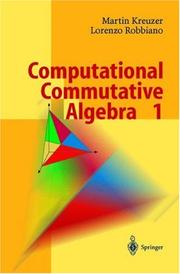
ISBN: 354067733X 3540255273 3540706283 3642064914 3540282963 9783540677338 9783540255277 Year: 2005 Publisher: Berlin, Heidelberg : Springer Berlin Heidelberg : Imprint: Springer,
Abstract | Keywords | Export | Availability | Bookmark
 Loading...
Loading...Choose an application
- Reference Manager
- EndNote
- RefWorks (Direct export to RefWorks)
Computational Commutative Algebra 2 is the natural continuation of Computational Commutative Algebra 1 with some twists, starting with the differently coloured cover graphics. The first volume had 3 chapters, 20 sections, 44 tutorials, and some amusing quotes. Since bigger is better, this book contains 3 chapters filling almost twice as many pages, 23 sections (some as big as a whole chapter), and 55 tutorials (some as big as a whole section). The number of jokes and quotes has increased exponentially due to the little-known fact that a good mathematical joke is better than a dozen mediocre papers. The main part of this book is a breathtaking passeggiata through the computational domains of graded rings and modules and their Hilbert functions. Besides Gröbner bases, we encounter Hilbert bases, border bases, SAGBI bases, and even SuperG bases. The tutorials traverse areas ranging from algebraic geometry and combinatorics to photogrammetry, magic squares, coding theory, statistics, and automatic theorem proving. Whereas in the first volume gardening and chess playing were not treated, in this volume they are. This is a book for learning, teaching, reading, and most of all, enjoying the topic at hand. The theories it describes can be applied to anything from children's toys to oil production. If you buy it, probably one spot on your desk will be lost forever!
Gröbner bases --- Commutative algebra --- Grobner, Bases de --- Algebre commutative --- Data processing --- Informatique --- Commutative algebra -- Data processing. --- Gröbner bases. --- Gröbner basis theory --- Mathematics. --- Computer science --- Algebra. --- Algebraic geometry. --- Computer mathematics. --- Algorithms. --- Computational Mathematics and Numerical Analysis. --- Symbolic and Algebraic Manipulation. --- Algebraic Geometry. --- Data processing. --- Algebra --- Geometry, algebraic. --- Algebraic geometry --- Geometry --- Computer mathematics --- Discrete mathematics --- Electronic data processing --- Algorism --- Arithmetic --- Mathematics --- Mathematical analysis --- Foundations --- Combinatorial analysis. --- QA 150-272 Algebra. --- Computer science—Mathematics. --- Group theory. --- Group Theory and Generalizations. --- Groups, Theory of --- Substitutions (Mathematics) --- Commutative algebra - Data processing --- Algebre commutative - Informatique
Book
ISBN: 3030264548 303026453X Year: 2020 Publisher: Cham : Springer International Publishing : Imprint: Springer,
Abstract | Keywords | Export | Availability | Bookmark
 Loading...
Loading...Choose an application
- Reference Manager
- EndNote
- RefWorks (Direct export to RefWorks)
This edited volume presents a fascinating collection of lecture notes focusing on differential equations from two viewpoints: formal calculus (through the theory of Gröbner bases) and geometry (via quiver theory). Gröbner bases serve as effective models for computation in algebras of various types. Although the theory of Gröbner bases was developed in the second half of the 20th century, many works on computational methods in algebra were published well before the introduction of the modern algebraic language. Since then, new algorithms have been developed and the theory itself has greatly expanded. In comparison, diagrammatic methods in representation theory are relatively new, with the quiver varieties only being introduced – with big impact – in the 1990s. Divided into two parts, the book first discusses the theory of Gröbner bases in their commutative and noncommutative contexts, with a focus on algorithmic aspects and applications of Gröbner bases to analysis on systems of partial differential equations, effective analysis on rings of differential operators, and homological algebra. It then introduces representations of quivers, quiver varieties and their applications to the moduli spaces of meromorphic connections on the complex projective line. While no particular reader background is assumed, the book is intended for graduate students in mathematics, engineering and related fields, as well as researchers and scholars.
Algebra. --- Field theory (Physics). --- Algebraic geometry. --- Associative rings. --- Rings (Algebra). --- Category theory (Mathematics). --- Homological algebra. --- Differential equations. --- Partial differential equations. --- Field Theory and Polynomials. --- Algebraic Geometry. --- Associative Rings and Algebras. --- Category Theory, Homological Algebra. --- Ordinary Differential Equations. --- Partial Differential Equations. --- Gröbner bases. --- Gröbner basis theory --- Commutative algebra --- Partial differential equations --- 517.91 Differential equations --- Differential equations --- Homological algebra --- Algebra, Abstract --- Homology theory --- Category theory (Mathematics) --- Algebra, Homological --- Algebra, Universal --- Group theory --- Logic, Symbolic and mathematical --- Topology --- Functor theory --- Algebraic rings --- Ring theory --- Algebraic fields --- Rings (Algebra) --- Algebraic geometry --- Geometry --- Classical field theory --- Continuum physics --- Physics --- Continuum mechanics --- Mathematics --- Mathematical analysis
| Listing 1 - 10 of 10 |
Sort by
|

 Search
Search Feedback
Feedback About UniCat
About UniCat  Help
Help News
News